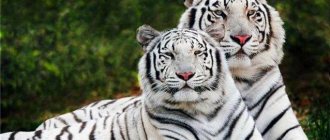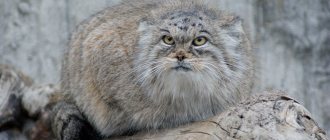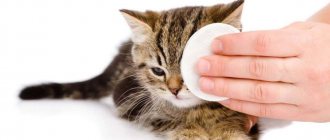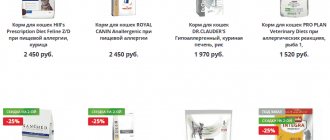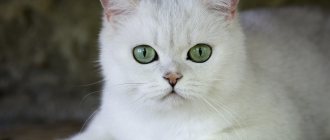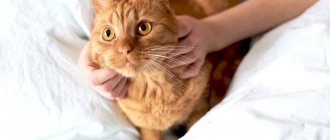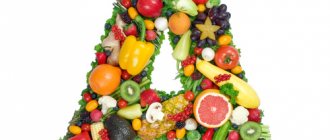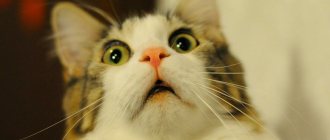What is inbreeding?
Breeders use 2 methods of selecting individuals for mating: interspecific (to introduce new characteristics not characteristic of the breed) and purebred (to crystallize and preserve the desired traits). The second method has 2 varieties:
- Outbreeding, that is, mating of unrelated animals. From English “out” - outside and breeding - breeding.
- Inbreeding (or “inbreeding”), when individuals of varying degrees of relatedness are mated. From English "in" - inside.
The second method is a kind of incest in the animal world, so the attitude towards the method on the part of newbie breeders is ambiguous. Nevertheless, this is necessary for breeding new breeds, consolidating stable traits within the group, and obtaining information about breed deficiencies. But you should prepare for possible difficulties.
The meaning of inbreeding is that in order to crystallize the desired breed trait, animals possessing it are crossed.
As a result of such crossing, purebred animals are achieved.
Since common ancestors indicate the presence of identical gene alleles, the higher the degree of relationship, the higher the probability of homozygosity.
The process itself consists of the following stages: primary selection of parents, crossing, culling and repeating the cycle. After birth, kittens that do not have desirable traits are selected. The rest mate with each other or with their parents. This happens until a stable breed/trait is obtained.
Genetics of Scottish cat colors
Scottish fold cats come in different colors; to get kittens of the desired color you need to choose parents with knowledge of genetics:
- In order for a Scottish kitten to turn out red or cream, the coat of both the male and female must be the required color.
- Dominant colors (white, black, smoke, tabby, bicolor, chinchilla) are passed on from parents to offspring, not through generations.
- A Scottish kitten with a dominant color has at least one dominant parent.
- If both dad and mom have a recessive color (cream, blue), then they will not have a single dominant cub.
- A cub with a light undercoat must have a parent with the same undercoat.
- A Scottish chinchilla kitten must have at least one parent with this coat (or tabby). And a tabby baby must have at least one tabby (or chinchilla) parent.
- A chinchilla cat can give birth to smoky offspring, but a smoky cat cannot become the mother of chinchilla kittens.
- A bicolor Scottish kitten must have one of its parents bicolor.
- To produce a color point litter, both mom and dad must be this color.
The owners are responsible for the success of mating and the health of their pets. It is important to choose the right individuals, prepare a comfortable place for them, and minimize stress. Inexperienced owners should consult with breeders and breed club specialists before organizing mating.
Did you like the article?
Degrees of inbreeding
There are 2 methods for determining the degree: Shaporuzh-Push and Wright-Kislovsky. A formula is proposed for quantitative calculation of the degree of relationship through the calculation of the coefficient. This option was first proposed by S. Wright, later D. Kislovsky derived a formula for these purposes. At the beginning of the twentieth century, A. Shaporouzh introduced and Push supplemented the designation, which indicates the pedigree and proximity of relatives. First, the pedigree is determined and its ranks are written out. The number is put in Roman numerals starting from the mother's side, then the number from the father's side separated by a dash. Next, the degree of relatedness of the crossed individuals is indicated. Marking is done with the corresponding numbers:
- I father, mother;
- II grandfather, grandmother;
- III great-grandfather, great-grandmother.
To preserve all the qualities of a particular breed, animals of the first line of kinship may be allowed for crossing.
Depending on the closeness of the crossing, inbreeding is divided into types according to the degree of relatedness:
- Close (incest) - parents, children, siblings.
- Close - cousins, grandfathers, grandmothers.
- Moderate - uncles, aunts, great-grandparents, great-grandchildren.
- Distant (both 4th and 5th) - cousins, aunts, great-uncles, grandmothers.
How to prepare an animal before mating
You should not wash him or her with shampoo - this will remove the natural odor that affects the sexuality of cats. For the first mating of a cat, the male must be untied, this reduces the likelihood of psychological trauma in the pet.
Among professional breeders, the male's home is considered a suitable place for mating. A cat is brought in there and an acquaintance takes place. The female either lets the cat in or drives her away, repeating these techniques. Then, when anger is replaced by mercy, quick sexual intercourse is performed (the total number in an hour sometimes reaches 8 times).
The following signs will help you find out that the action is over (and the owners are not required and not even recommended to be in the same room during mating):
- If after mating the female lies on her back and rolls around on the floor.
- The male has moved away and is licking his genitals with indifference.
However, the cat is not taken from the groom’s house; the entire mating cycle is completed after 5 days, sometimes in a couple of days if the female gets to know the male quickly and gets to know him closely. Therefore, while the pet is in the guest room, they put a tray, her food and water bowls in her luggage, and leave a carrier with her scent so that the cat can sleep and rest there. When the female is ready for intercourse again, she will begin to flirt with the cat.
Important! It is the responsibility of the owners of the female to inform the opposite party about the results of mating after three weeks.
There are also non-standard cases that require solutions. This is due to incompatibilities in the cat family. For example, size discrepancy, the male is smaller than the female. In such a situation, the cat’s genital organ, resting against the cat’s back, is not able to fertilize her. This means that the male has to be guided.
Consequences
Kin breeding has its strengths and weaknesses. The advantages include the ability to quickly identify the desired characteristics of the breed, consolidate stable traits, and obtain information about the advantages and disadvantages of the breed, including genetic diseases. Disadvantages include receiving both the desired dominant genes and harmful ones, reducing the vitality of the breed, and deformities. That is, undesirable traits are fixed - so-called inbred depression occurs.
The result is the need for strict culling of kittens (sometimes up to 80%). When it is undesirable to cross too close relatives, an option would be mating with animals of a breeder who is working on similar problems, or parallel breeding of several lines, the individuals of which are then mated. These options have significant disadvantages for breeding work - they do not allow you to quickly obtain information about the characteristics of the breed, because 98% of homozygosity in the 16th generation is achieved after mating along the closest line: parents and children or siblings (sisters and brothers). If you mate cousins, you can achieve only 65% homozygosity. An ill-conceived selection strategy can have dire consequences - a decrease in vitality and fertility leads to the extinction of an entire line.
This article is addressed to those cat lovers and owners of catteries, as well as the chairmen of those clubs and associations whose main goal is to consolidate and improve the pedigree qualities of their animals through purebred breeding and selection (selection). Let us immediately emphasize that since selection involves strict culling, this goal comes into conflict with commercial cat breeding, where the main goal is profit. Inbreeding as a component of purebred breeding. In the course of his work, the breeder must decide which females should be mated with which selected males so that their offspring will combine certain characteristics and acquire improved traits. This selection event is called selection of pairs for crossings. The selection of pairs should be carried out systematically and systematically, and its goal is to change the genetic structure of the animal population of a given nursery in the desired direction or to preserve and consolidate a certain combination of valuable traits in the offspring. Sometimes, to breed new breeds or introduce completely new characteristics into a breed that were not previously characteristic of it, interbreeding or even interspecific crossing is used, but usually the main direction of the breeder’s work is the so-called purebred breeding - mating of individuals of the same breed.
Purebred breeding is divided into two types: outbreeding - a system of unrelated matings of animals within a breed, and inbreeding - a system of matings of individuals having a close degree of relationship, such as brother-sister, father-daughter, mother-son, cousins, etc. . In general, inbreeding assumes that the mated individuals - the future father and mother - have common ancestors or at least one common ancestor. Although for specialists the importance and necessity of inbreeding in purebred breeding is obvious, among amateurs there are a lot of myths and prejudices, both against inbreeding itself and against the use of inbred sires in breeding. (We will say in advance that the latter is a particularly big mistake, since inbred selective sires are, as a rule, prepotent - their children turn out to be mostly like their father - and also often produce exceptionally strong offspring.)
Genetic basis of inbreeding
. What is the biological (genetic) essence of inbreeding? All modern breeds of animals, including cats, are heterozygous for many genes. This means the following. The zygote - a fertilized egg - receives one complete set of genes from both the father and the mother, so that it has a double set of them. If both genes responsible for a given trait - one from the father and the other from the mother - are identical, then this condition is called homozygous for this gene, and an individual homozygous for this gene will develop from the egg. If the genes of the equivalent pair, for example, those determining the formation of black hair pigment, are different (say, the father passed on the black color gene C, and the mother passed on a modified, for example, Himalayan, cs gene), then the individual will turn out to be heterozygous for this gene (Ccs). In the latter case, the black color gene is dominant, and the animal will be externally (phenotypically) black, but will be a carrier of the recessive (hidden) Himalayan gene. If such a heterozygous animal - let it be a black cat, a carrier of the Himalayan gene - is crossed with its sister, also a black cat, carrying a hidden Himalayan gene, then a split will be observed in the offspring (Fig. 1): part of the offspring will be black in color (CC - homozygous , and Cсs are heterozygous genotypes), and the other part is Himalayan (сссs homozygous genotype). This happens because when crossing this black cat with his black sister, their gamete sex cells (sperm and egg) - carrying a single set of genes, will occur in all four possible combinations: C from cat and C from cat, C from cat and cs from cat, cs from cat and C from cat, cs from cat and cs from cat. Therefore, with a probability of 1/4, two Himalayan genes (one from the father, the other from the mother) will converge in one zygote and give a homozygous Himalayan genotype and, therefore, a Himalayan phenotype in some kittens of the litter. The other part of the litter, with the same probability of 1/4, will be homozygous for the solid black gene (CC). Thus, the genetic essence of inbreeding comes down to the process of decomposition of a population into lines with different homozygous genotypes. Since during inbreeding, genes that were in a heterozygous state pass into a homozygous state; in the next generation, when crossing homozygous animals of the same color, no splitting will be observed. In this way, with the help of inbreeding, hidden traits are identified, desired traits are consolidated in generations, and stable genetic lines are created.
The fastest practical way to increase homozygosity in higher animals is to mate siblings who have the same father and mother (it makes no difference whether the sibs are taken from littermates or from different litters), as well as to mate father and daughter or mother to son.
The opinion sometimes expressed among non-professionals that, they say, it is possible to mate a father with a daughter, but not a mother with a son, is a myth that has no basis; the effect of both types of inbreeding is exactly the same. If such close inbreeding (incest) is carried out for 16 generations in a row, then 98% homozygosity is achieved for all genes, and therefore, due to the absence of segregation, all individuals of these litters become almost identical in genotype and phenotype - all children are identical, like twins, Of course , in practice, a much smaller degree of inbreeding is usually used, and accordingly a much lower degree of homozygosity is achieved.
It should be noted that the mating of second cousins (common great-grandfather) leads to an increase in homozygosity by only 2% over an infinite number of generations. Consequently, inbreeding of this type is already fundamentally different from closer degrees of inbreeding and essentially does not lead to the achievement of the goals that are placed before the system of consanguineous matings. Breeders who, for one reason or another, avoid inbreeding may not be afraid to mate second cousins.
Determining the degree of inbreeding and the inbreeding coefficient in cats
. Based on the analysis of the animal's pedigree, it is possible to qualitatively assess the degree of inbreeding, which is expressed by the saturation of the pedigree with common ancestors (nicknames) on the maternal and paternal lines. According to Shaporouge, Roman numerals denote generations (a series of ancestors), counting the parent as the first, grandfather as the second, etc. If a common ancestor is repeated in both the maternal and paternal parts of the pedigree, then its occurrence in the maternal pedigree is indicated first, and then, after a dash, in the paternal pedigree. Then the crossing son x mother will be designated as I-II (Fig. 2, a), father x daughter as II-I (Fig. 2,6), brother x sister as II-II (Fig. 2, c, d) , grandfather x granddaughter as III-I (Fig. 2, e), cousins x sister as IIIIII (Fig. 2, f), etc. Inbreeding type father x daughter (II-I), son x mother ( I-II) and brother x sister (II-II) is designated as very close, or incest; inbreeding type II-III or III-II is close inbreeding; and crossing III-IV, IV-III, IV-IV, II-V, etc., is moderate inbreeding. Due to the lack of perceptible effects, more distant inbreeding may in practice not be considered true inbreeding. Owners of high-quality purebred cats, having picked up the cat's pedigree, can themselves assess how often and to what extent inbreeding was used by the breeders who participated in the breeding of this pet.
To quantitatively take into account the degree of inbreeding in the pedigree of an animal and thereby determine the measure of its homozygosity, the English geneticist S. Wright introduced the concept of inbreeding coefficient (F). This coefficient is calculated as follows. First, the number of generations (arrow - such as in Fig. 2) from the common ancestor A of the father and mother to the father of a given animal (p) is calculated, then the number of generations (arrow) from the same ancestor A to the mother (m). These numbers are summed up, and one is added to the sum: n = p+ m+ 1. The inbreeding coefficient of the analyzed animal (proband X) for this ancestor is equal to 1/2 to the power of n: Ga = (1/2)n. If the father and mother have several common ancestors, then the coefficients are summed up: Fx =EF, =E(1/2)n, where i are the common ancestors of A, B, C, etc.
As an example, let’s calculate the inbreeding coefficient of an animal (proband X) obtained from crossing siblings (II-II, Fig. 2c). In the pedigree, the distance (path) from grandfather to father is 1 generation, from grandfather to mother is 1 generation, therefore, n = 1 + 1 + 1 = 3, which means Fв = (1/2)3 = 1/8. But they have one more common ancestor - their grandmother; from her to her father is 1 generation, from her to her mother is 1 generation, and therefore Fa will also be 1/8. The overall inbreeding coefficient for X is Fx = Fa+ Fb = 1/8+ 1/8 = 1/4, or 0.25.
Another example is the crossing of a grandfather with a granddaughter (III-I, Fig. 2,e). Here the offspring on the paternal line have no generations (arrows), i.e. 0 generations, on the maternal side - 2 generations, whence n = 0 + 2 + 1 = 3, and then Fx = (1/2)3 = 1/8, or 0.125.
Finally, an example with crossing cousins with sister (III-III, Fig. 2, f). The common ancestors of their offspring are their great-grandfather and great-grandmother. From great-grandfather to father - 2 generations, from him to mother 2 generations, i.e. n = 2 + 2 + 1 = 5, and accordingly Fb = (1/2)' 1/32. The same is obtained when calculating the inbreeding coefficient for another common ancestor - great-grandmother: Fa = (1/2)3 = 1/32. Therefore, the total inbreeding coefficient Fx = Fa + Fb = 1/32 + 1/32 = 1/16, or 0.0625.
From available pedigrees, each breeder or owner of a purebred animal can calculate the inbreeding coefficient of their pets or their parents and grandparents - if inbreeding was used in their production. As already mentioned, this coefficient is an indicator of the degree of purity (homozygosity) of the lines participating in the pedigree, as well as an indication of the possible prepotency of the corresponding sires and/or female sires (see below). The higher the inbreeding coefficient of an animal, the more of its genes are in a homozygous state. Naturally, as follows from the formula, the inbreeding coefficient cannot exceed one.
Inbreeding depression and heterosis
. Why is it that in human society, in most civilizations, there is either a direct ban on incest or condemnation of it? Moreover, why in the wild is everything adapted in such a way as to avoid inbreeding and homozygosity as much as possible? The main reason is that both wildlife and human society require a variety of genotypes and individuals in the population to successfully survive and adapt to changing environmental conditions (including social and economic conditions in the case of human society). In a diverse community there will always be individuals best adapted to a given specific situation; however, the situation is changing - and other individuals, with other signs, float to the surface. The uniformity of a population, although well adapted to the given specific conditions of its existence, dooms a biological species to extinction when conditions of existence change. Thus, the desire to create diversity is necessary not for individual individuals, but for the entire species to meet the various and changing demands of the environment and the historical process .
But there is also a direct danger of inbreeding for individual individuals. The fact is that both during the individual life of an animal (and a person), and over generations, mutations—gene changes—occur from time to time. Most mutations are harmful, and if they immediately manifested themselves, they would lead to death (lethal mutations), deformities, abnormal behavior, inconsistencies with the environment, etc. However, most mutations are at the same time recessive in nature, i.e. in combination with a normal paired gene, due to the double set of genes, does not appear in the heterozygous state. The burden of such harmful, but not manifested, hidden mutations is present in every heterozygous individual, including every person. Inbreeding creates homozygosity, including homozygosity for harmful genes, and, consequently, leads to their phenotypic manifestation in the offspring - intrauterine or early death, deformities , reduced viability, etc. This phenomenon is called inbreeding depression.
Let's ask the opposite question: why, despite the danger of inbreeding depression, do breeders who breed and improve domestic animals so often resort to inbreeding and are not afraid of it? The answer is simple: breeders do not strive to ensure maximum survival, vitality and high qualities of all offspring, but select the best, culling (for example, castrating) defective, weak and simply undesirable traits. Thus, during inbreeding, when the genotype is decomposed into homozygous lines, harmful recessive genes appear and are removed from further breeding, and all “good” genes and their combinations are fixed in a homozygous state and left for further generations. Thus, inbreeding in the hands of a breeder is a way of removing the load of harmful mutations from the genotype, on the one hand, and creating the necessary combinations of valuable genes and traits, on the other. In addition, thanks to homozygosity, the homogeneity necessary for breeding any new breed is created, meeting the requirements of this breed, and the corresponding valuable traits are fixed in the offspring. It should be noted that as inbreeding and selection of the best, due to getting rid of the burden of harmful hidden mutations, the danger of inbreeding depression during inbreeding of selected inbred animals decreases.
When crossing between representatives of different independent inbred lines, a phenomenon can be observed that, in a certain sense, is the opposite of inbreeding depression - heterosis, also called “hybrid vigor.” Such hybrids of two inbred animals usually show increased vitality, growth, fertility, etc. This occurs because when crossing between two inbred lines selected and therefore similar in typical characteristics of the breed, homozygosity for these selected characteristics is preserved in the offspring, whereas the remaining harmful mutations that are not rejected are transferred to a heterozygous state and thereby become recessive, i.e. do not appear.
Practice the goals of inbreeding cats. Let us consider in general and summarize the tasks that are performed and the goals that are pursued by livestock breeders, including cat breeders, when using inbreeding.
First, inbreeding is necessary when developing a new breed or a new group within a breed. To increase genetic diversity and attract new traits, the breeder crosses animals of different breeds. The resulting hybrid offspring is heterozygous and will therefore produce segregation in subsequent generations. To consolidate the desired combinations of traits, inbreeding is mainly used close, such as brother x sister, father x daughter and mother x son. As a result of inbreeding, homogeneous families are created and a constant manifestation of traits is achieved. Among inbred offspring, up to 80% of the animals are strictly culled - defective, weak and not meeting the intended standards.
In Fig. Figure 3 shows an example of very close inbreeding when breeding Himalayan cats with lilac markings (lilac point) in the English Mingchew cattery. A cat with a chocolate-point color - Snuff - was obtained by crossing a Tromo cat, with a seal-point color, a carrier of the chocolate and blue genes, from the American nursery Briery, with a Siamese cat Trayvia, also a seal-point and also a carrier of the chocolate and blue genes, from cattery Mingchshch, This chocolate-point cat (Snuff) was bred with her father, the cat Tromo. The cat Chock, a seal-point, born from them was bred with his mother, the cat Snuff, a chocolate-point. From them the first cat with lilac markings (lilac point) was born - Sulatri. It is worth noting the very high inbreeding coefficient of Sulatri: P 3/8, or 0.375, i.e. higher than when crossing siblings.
Secondly, close (very close) inbreeding is used in cases where it is necessary to identify producers who are carriers of lethal, semi-lethal and other undesirable genes. This is the so-called test inbreeding. Based on the results of test inbreeding, various decisions can be made: either such sires are discarded or used to produce homozygous offspring (through inbreeding) with the culling of defective ones and the selection of the best ones, thereby achieving purification of the genotype from unwanted genes.
Thirdly, the purpose of inbreeding may be to breed a highly potent producer, that is, one that effectively passes on its traits to children. It is known that inbred animals have a higher individual prepotency compared to individuals obtained from unrelated crosses. Because of this, it is a widely accepted practice in animal husbandry to mate an inbred male with a non-inbred female; This practice is called top crossing. It is important that a good inbred producer, passing on his selected qualities to his descendants, can significantly improve the nursery stock and give it its own face, its own peculiarity, its own type.
Fourthly, sometimes breeders create inbred lines in their nurseries, so that later, by crossing representatives of different lines (often this is done in cooperation between different nurseries), they can obtain the effect of heterosis - powerful, large, resilient and fertile offspring.
In conclusion, we would like to emphasize that in order to conduct breeding work - including with cats - it is necessary to use systems of competent selection and selection of animals. In this case, selection is distinguished by phenotype and by genotype. Cat lovers are well acquainted with cat shows of various levels, where class assessment (in professional language - grading) of cats is carried out. This is an assessment based on phenotype. Assessment by genotype should be carried out based on the pedigrees of animals and the quality of their offspring. Generally speaking, the breeding value of an animal can be determined only by evaluating the sire by the quality of his offspring. An animal of excellent phenotype will not always be a good producer. Livestock breeders have a catchphrase: “A good bull is worth half a herd.” The same is with stud cats: the quality of the cattery and its personality is largely determined by the stud cat (or stud cats, if there is more than one). Such a stud cat must be highly prepotent, and therefore breeders should turn their attention to inbred studs. Moreover, you cannot create a good nursery by simply purchasing expensive animals with champion and grand champion titles abroad. It is necessary that in the nursery itself and from the nursery producers on the side, animals of the international champion and grand champion level are born. And this requires competent breeding work, in which inbreeding plays a significant role.
Safari (safari cat, criollo, aplausa)
Safari breed history: Safari is a hybrid of a domestic cat and a Geoffroy wild cat, a representative of the South American fauna. For the first time, such a hybrid was obtained in the 1970s at the University of Washington, where research was carried out on feline viral leukemia (for the same reason, Bengals appeared).
However, work on the safari at the university was soon stopped; there was information that it was continued by American felinologists, but today the fate of the breed is unknown. Most likely, due to genetic difficulties, the breed ceased to exist, but some individuals could remain with their owners.
Safari character: Safaris are independent, intelligent and affectionate, but can also exhibit wild traits.
Experienced male and female breeders know general recommendations for successful breeding of animals.
A diet that includes high-quality natural products is important. Meat and fish, vegetables, as well as holistic or high-end food are suitable.
Examinations at the veterinary clinic should be regular for both male and female cats. In the absence of visible signs of disease, the animal may have a congenital or chronic disease. Such a gene pool is dangerous for future offspring due to its possible acquisition. Twice a year is the norm for medical examinations for your pet.
Frequent mating is actually harmful, even despite the constant readiness for coitus from a sexually mature male. Constant mating reduces the quality of sperm, which will certainly affect the future litter. The break between knots should be at least a week.
Mating can be stressful for a cat, but you shouldn’t stuff your pet with tranquilizers. There is a possibility of disruption of estrus, and therefore the entire process. Although the trip turns out to be a shock for the female, we must try to calm her down without sedatives, for example, by taking with her her favorite things with a familiar home smell. This will give the cat confidence, and therefore the possibility of mating.
Everything that is needed and how the first mating of a cat with a cat occurs should be known to the responsible owners (apparently, these are the “parents” of the male). Their duty is to comfortably help pets mate. You cannot quickly or forcefully bring animals together; they will decide for themselves whether they are ready for intercourse or not. Successful mating can occur the next day.
